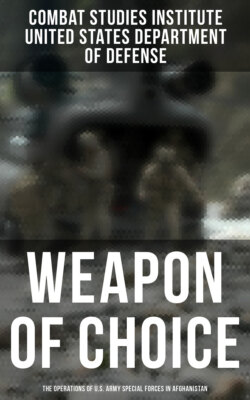Читать книгу Weapon of Choice: The Operations of U.S. Army Special Forces in Afghanistan - Combat Studies Institute - Страница 23
На сайте Литреса книга снята с продажи.
Making Camp Freedom a Fully Operational Base: K2, Uzbekistan
ОглавлениеThe key to command, control, and operations is communications. Thirty-five soldiers from A Company, 112th Signal Battalion, were quite surprised when they arrived shortly after dark on 6 October. Because their C-17 aircrew had warned them to be prepared for a hostile environment, they donned full combat gear and stood with their weapons at the ready, expecting the worst when the aircraft ramp was dropped. Then, instead of a hostile environment, the “charged-up,” battle-ready soldiers faced a female Air Force captain, the JSOTF chief of personnel, CPT Childs (pseudonym), and Air Force MAJ Victor Mercado (pseudonym), the chief of communications. The surprised troops were welcomed to Camp Freedom and then ushered to a customs tent for in-processing. This was the standard procedure for most of the early chalks. For some unknown reason, neither the C-17 aircrews nor the inbound troops ever received the truth about the real threat at K2.
Figure 41. 112th Signal Battalion satellite antennas.
The personnel who would establish the SOCCENT Joint Special Operations Air Component (JSOAC) headquarters, the command element responsible for the CSAR mission, followed the signalers. When MAJ Wes McKellar (pseudonym), D Company, 2nd Battalion, 160th SOAR, arrived, he remarked, “You know you’ve won the Cold War when you walk out the back of a C-17 carrying an American flag, loaded weapons, and have Soviet helicopters flying CAP [overhead air cover].”
Figure 42. K2 buildup.
Figure 43. MH-47E landing at K2.
LTC James Brinks (pseudonym), commander, 2nd Battalion, 160th SOAR, had been tasked to command the JSOAC. Having an Army aviator in charge of a JSOAC in combat was a first. With no experience in the battalion, MAJ Mark Henderson (pseudonym), the operations officer (S3), had his hands full. Thus, in the first few days, during the simultaneous “standup” of JSOTF-North and the JSOAC, the 160th SOAR officers and NCOs worked for both staffs to support the personnel recovery mission that had to be in place to begin the air campaign. Learning curves were steep, but being ready to perform the personnel recovery mission drove the collective effort. Within days, SOF air assets to support the mission included two MC-130P tankers from 9th SOS, a number of special tactics squadron (STS) teams from the 23rd STS, a joint Army-Air Force staff, and four MH-47E Chinooks and two MH-60L Direct Action Penetrators (DAPs) from 160th SOAR. When the strategic bombing campaign was moved up to begin on the evening of 7 October, the urgency became acute. The JSOTF and JSOAC had to be ready to support the air campaign despite the disorderly airflow.
Figure 44. MH-60L DAPs.
